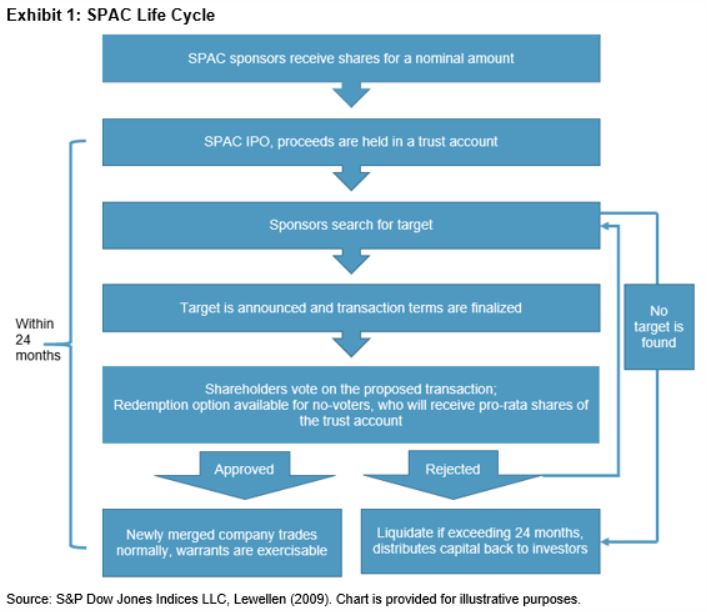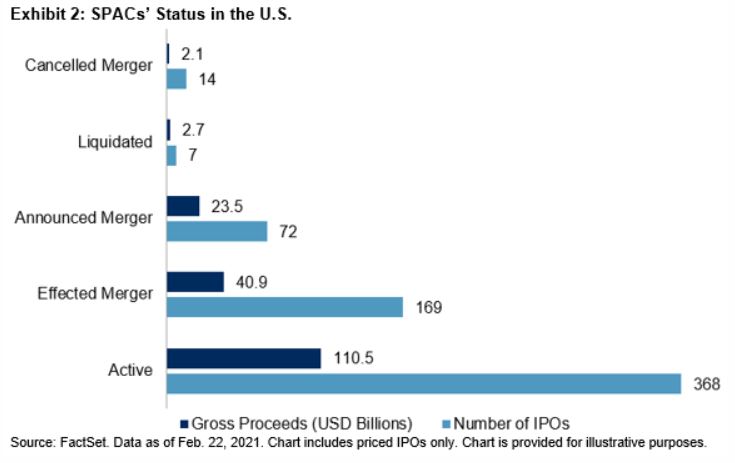S&P Global Offerings
Featured Topics
Featured Products
Events
S&P Global Offerings
Featured Topics
Featured Products
Events
S&P Global Offerings
Featured Topics
Featured Products
Events
Featured Products
Ratings & Benchmarks
By Topic
Market Insights
About S&P Global
Corporate Responsibility
Culture & Engagement
Investor Relations
Featured Products
Ratings & Benchmarks
By Topic
Market Insights
About S&P Global
Corporate Responsibility
Culture & Engagement
Investor Relations
S&P Global Offerings
Featured Topics
Featured Products
Events
Language
S&P Dow Jones Indices — 24 Mar, 2021
By Jason Ye
This article is reprinted from the Indexology blog of S&P Dow Jones Indices.
In the previous blog(opens in a new tab), we introduced SPACs and discussed market trends that emerged given SPACs’ popularity. In this blog, we will discuss SPACs’ lifecycle, as well as the benefits and risks of investing in SPACs.
SPAC Life Cycle
There are three stages in a typical SPAC life cycle.
1. A SPAC’s IPO
When SPAC sponsors form a SPAC, they are typically given 20% of the post-IPO shares for a nominal investment amount. The SPAC then goes through the IPO process. In a typical SPAC structure, the SPAC raises capital by issuing units consisting of one share and one-half or one-third of a warrant. On NASDAQ for example, the shares are generally priced at USD 10 and the warrants are typically struck 15% out of the money (USD 11.50) with a five-year term and a USD 18 forced exercise.1
The capital raised is held in a trust account. The common stock and the warrant typically begin to trade separately, starting on the 52nd day following the IPO.2 Thus, a SPAC could have multiple instruments listed simultaneously, including unit, common stock, and warrant.
2. Seeking a Target
After the IPO, the sponsors will start to search for an acquisition target and finalize the transaction terms once the target is found. NASDAQ requires that the transaction must be valued at 80% or more of the funds held in the trust.3 Typically, the sponsors have 18-24 months to find a target.4
3. De-SPAC
Once the acquisition target is found, depending on the SPAC’s prospectus, shareholders may need to vote on the transaction, or they will receive redemption notices if they choose to receive a pro-rata amount from the trust account and walk away. If the acquisition is approved by shareholders, the SPAC merges with the target company and will often undergo an identifier change to reflect the name of the target business. Otherwise, the sponsor will resume searching for another target. If the sponsor fails to find a suitable target within the pre-defined timeframe, the SPAC will be liquidated, and the investors will receive their capital back from the trust account. This process is detailed in Exhibit 1.

Based on a SPAC’s life cycle, we can split a SPAC’s status into five categories: active, announced merger, effected merger, cancelled merger, and liquidated. Currently, most SPACs in the U.S. are actively looking for the acquisition target (see Exhibit 2).

Benefits and Risks of SPAC Investing
Market participants can gain several benefits through investing in a SPAC, compared with investing in private equity.
However, investors should also be aware of the risks involved when investing in SPACs.
Summary
A typical SPAC goes through three stages during its life cycle: IPO, seeking a target and business combination (de-SPAC). When investing in SPACs, investors gain access to private equity-like opportunities with downside protection. However, investors should also be aware that SPACs possess no assets, and sponsors’ interests may not align with those of the investors. In the next blog, we will analyze SPACs’ liquidity and historical performance.
Reference:
Lewellen, S. (2009). SPACs as an Asset Class. Available at SSRN 1284999 http://ssrn.com/abstract=1284999(opens in a new tab)
1 The specific terms of listing price and warrant depend on the individual IPO prospectus.
3 https://www.sec.gov/rules/sro/nasdaq/2020/34-90245.pdf(opens in a new tab).
4 NASDAQ allows 36 months for SPACs to complete business combination; SPACs are also allowed to extend this deadline per shareholders’ approval.
The posts on this blog are opinions, not advice. Please read our Disclaimers.
Content Type
Location
Segment
Language
